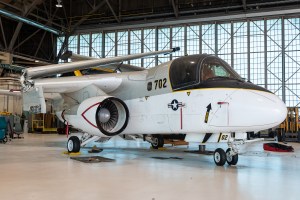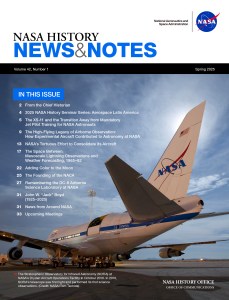The primary goals of Project Gemini included proving the techniques required for the Apollo Program to fulfill President John F. Kennedy’s goal of landing a man on the Moon and returning him safely to Earth before the end of the 1960s. Paramount among those techniques was rendezvous and docking, required to implement the Lunar Orbit Rendezvous method NASA chose for the Moon landing missions. Additional goals of Gemini included proving that astronauts could work outside their spacecraft during spacewalks and ensuring that spacecraft and astronauts could function for at least eight days, considered the minimum time for a roundtrip mission to the Moon. The first five Gemini missions in 1965 demonstrated the new spacecraft’s space worthiness, the feasibility of spacewalking, extended flight durations to eight and 14 days, and demonstrated space rendezvous techniques. The goals of Gemini VIII, the first mission of 1966, included docking with a target vehicle and conducting a lengthy spacewalk during a three-day flight. The actual flight did demonstrate the first docking, but a stuck thruster resulted in an early emergency return.

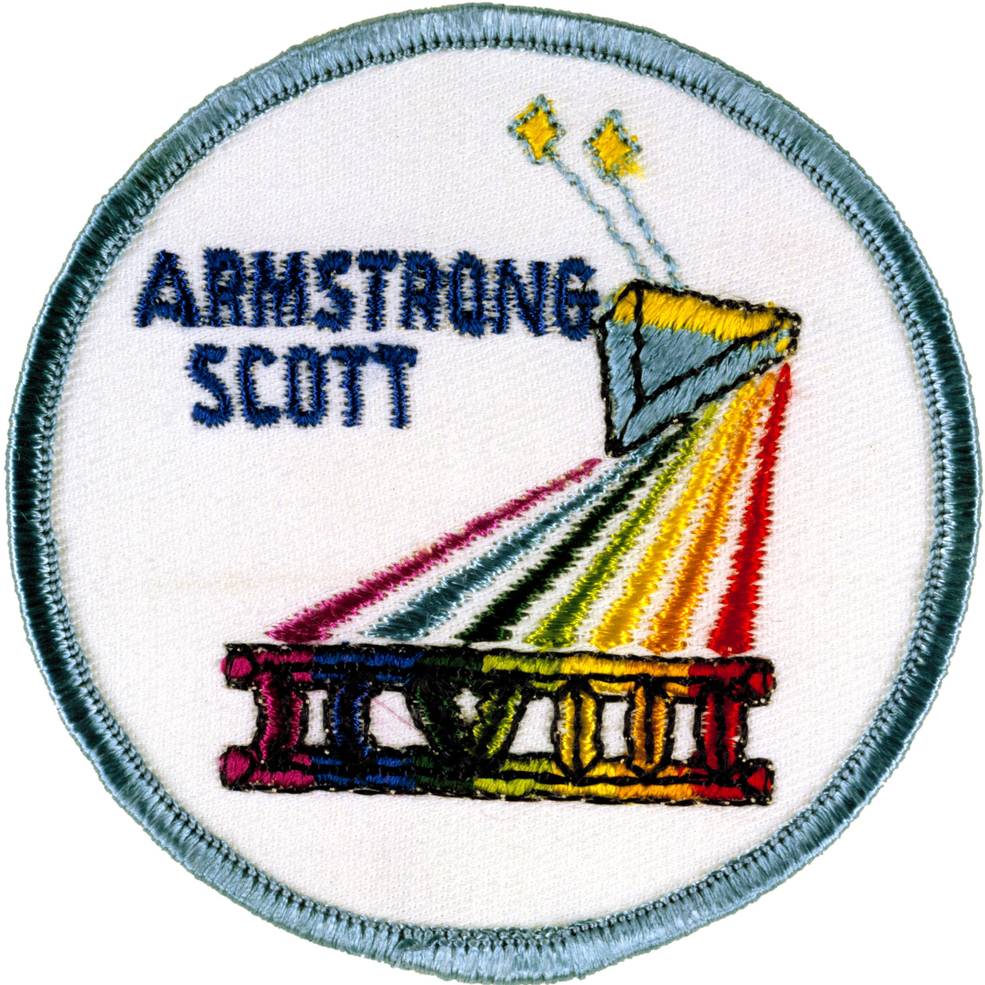
Left: Gemini VIII astronauts David R. Scott, left, and Neil A. Armstrong.
Right: The Gemini VIII crew patch.
For the Gemini VIII mission, NASA assigned space rookies Neil A. Armstrong, the command pilot, and David R. Scott, the pilot, selected as astronauts in 1962 and 1963, respectively. The backup crew consisted of Gemini V veteran Charles “Pete” Conrad and rookie Richard F. Gordon, also selected in 1962 and 1963, respectively.


Left: Gemini VIII prime crew, David R. Scott, left, and Neil A. Armstrong and backup crew members Charles “Pete” Conrad and Richard F. Gordon, during the preflight press conference. Right: The Gemini Agena docking simulator at the Manned Spacecraft Center, now NASA’s Johnson Space Center in Houston.
On Feb. 28, Armstrong and Scott, along with their backups Conrad and Gordon, described their planned three-day mission to reporters during a press conference at the Manned Spacecraft Center (MSC), now NASA’s Johnson Space Center in Houston. The flight plan called for Gemini VIII to launch about 90 minutes after their Agena target vehicle and confirmation that the target had achieved the correct orbit. Armstrong and Scott would begin the chase to catch up with the Agena, and less than seven hours after liftoff, Armstrong would guide Gemini VIII in for the world’s first docking. The astronauts rehearsed the docking in a simulator at MSC.



Left: Engineer Fred R. Spross of the Crew Systems Division at the Manned Spacecraft Center, now NASA’s Johnson Space Center in Houston, wearing the equipment planned for David R. Scott’s Gemini VIII spacewalk, including the chest-worn life support pack and the support backpack. Middle: Scott training to use the hand-held maneuvering unit on an air-bearing surface. Right: Scott training for his planned spacewalk in a zero-gravity aircraft.
The next day, Scott would exit the Gemini spacecraft for a planned two-hour spacewalk, only the second planned American spacewalk and far more complex than Edward H. White’s first brief excursion during Gemini IV the previous June. Wearing a chest-mounted life support system as a backup to his 25-foot tether that provided primary life support and communications, Scott planned to perform a few simple tasks near the open hatch. Next, Scott would translate to the rear of the spacecraft and back into a backpack support pack that included a 75-foot tether and a hand-held maneuvering unit. Meanwhile, Armstrong would undock the Gemini from the Agena and fly in formation 60 feet away. Using the maneuvering unit, Scott would translate to the end of his 75-foot tether. Armstrong flew the Gemini to retrieve him. Scott would reenter the spacecraft, ending the spacewalk, and Armstrong would redock with the Agena. During their third day in space, the crew would perform two more undocking and redocking exercises and conduct a series of experiments before firing their retrorockets for the trip back to Earth. Splashdown was planned for the western Atlantic Ocean, with retrieval by the prime recovery ship, the helicopter landing ship U.S.S. Boxer (LPH-4), and the crew would fly back to KSC for debriefings. As for all crewed missions, recovery forces stood by at several backup splashdown locations in case the crew needed to make an emergency landing.



Left: At the Cape Kennedy Air Force Station, now the Cape Canaveral
Space Force Station in Florida, NASA astronauts David R. Scott, left, and
Neil A. Armstrong arrive at Launch Pad 19 to board their Gemini VIII
spacecraft. Middle: The launch of the Gemini VIII Agena target vehicle
from Launch Pad 14. Right: The launch of Gemini VIII.
On the morning of March 16, 1966, at the Cape Kennedy Air Force Station, now the Cape Canaveral Space Force Station in Florida, workers at Launch Pad 19 strapped Armstrong and Scott into their Gemini VIII capsule. At nearby Launch Pad 14, the Atlas rocket carrying the Agena target blasted off precisely on time and placed the target into its correct orbit. Gemini VIII took off on schedule and reached orbit six minutes later. A team of controllers at the Mission Control Center (MCC) at MSC, led by Flight Director John D. Hodge, monitored the launch and the rendezvous. Gemini VII astronaut James A. Lovell served as the capsule communicator, the astronaut in the MCC who spoke directly with the crew in orbit.


Left: In the Mission Control Center (MCC) at the Manned Spacecraft Center, now
NASA’s Johnson Space Center in Houston, Flight Directors John D. Hodge, left, and
Eugene F. Kranz monitor the launch of Gemini VIII. Right: In the MCC, capsule
communicators James A. Lovell, left, and Williams A. Anders monitor the launch
of Gemini VIII.
Armstrong and Scott began the rendezvous with the Agena, firing the spacecraft’s thrusters in a series of maneuvers to close the distance between the two spacecraft. At a range of 206 miles, they established radar contact with their target and spotted it visually from 87 miles away, gleaming in the sunlight. Armstrong brought Gemini VIII within 150 feet of the Agena and maneuvered around the target as Scott visually inspected it. Then Armstrong brought the two spacecraft to within two feet of each other. Final checks complete, Armstrong received the call from the ground, “Go ahead and dock.” At a relative velocity of one foot per second, Armstrong brought Gemini VIII in for the final docking with the Agena, reporting to the ground, “Flight, we are docked.” After completing electrical connections between the two spacecraft, Scott commanded the Agena’s thrusters to roll the combined vehicle 90 degrees, Armstrong telling Lovell that it had “gone quite well.” Passing out of communications range over the Indian Ocean, Armstrong and Scott noticed their spacecraft began an unexpected roll. Assuming a problem had occurred with the Agena, Scott turned off its thrusters while Armstrong reactivated the Gemini’s to regain control over the spacecraft. The action worked temporarily, but the vehicle soon began unwanted motions in all three axes and at higher rates. Glancing at the instrument panel, Armstrong noticed the Gemini’s fuel supply had dropped to 30%, and realized the problem was with their craft and not the Agena. Armstrong quickly undocked but, rid of the heavier Agena, the Gemini spacecraft began tumbling at much higher rates, reaching a roll rate of one rotation per second. Coming back into communications range, Scott reported to a stunned MCC, “We have serious problems here. We’re tumbling end over end.” To regain control of the spacecraft, the astronauts shut down the main thruster system and activated the re-entry system thrusters. With this action, they stabilized the spacecraft, but mission rules dictated that once they activated the re-entry system, they must land at the next available opportunity. Scott’s ambitious spacewalk and the additional docking tests were cancelled. The post-mission analysis revealed that an electrical short circuit had caused thruster number 8 to stick in an open position, creating the wild gyrations and depleting the onboard fuel supply.

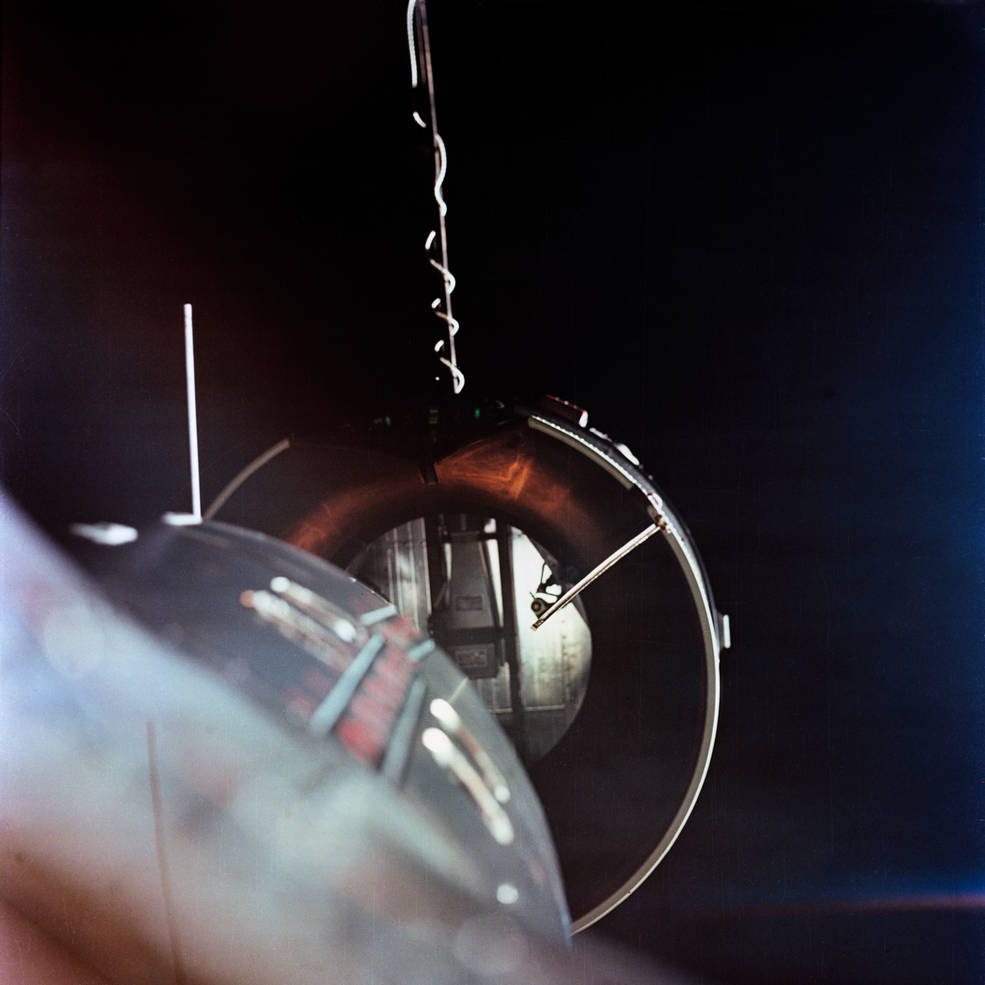

Left: The Gemini VIII astronauts inspect the Agena target vehicle from about 50 feet away. Middle: Gemini VIII just 2 feet from the Agena, closing in for the docking. Right: Gemini VIII achieves the first docking in space.
Instead of the planned splashdown in the western Atlantic Ocean and recovery by the U.S.S. Boxer, Gemini VIII now targeted a preplanned contingency area in the western Pacific Ocean 500 miles east of the Japanese island of Okinawa. A backup recovery ship, the destroyer U.S.S. Leonard P. Mason (DD-852), already assigned to the general area, immediately steamed toward the splashdown point. Aboard Gemini VIII, the disappointed astronauts fired their spacecraft’s retrorockets in the darkness over south-central Africa. Following the fiery re-entry through the Earth’s atmosphere, the Gemini capsule deployed its parachute and splashed down only 1.6 miles from its aim point after an abbreviated flight of 10 hours 41 minutes. Enjoy a video of the Gemini VIII mission.



Left: Gemini VIII astronauts David R. Scott, left, and Neil A. Armstrong aboard their spacecraft after splashdown, with U.S. Air Force pararescuemen standing on the flotation collar. Middle: Sailors hoist the Gemini VIII capsule aboard the U.S.S. Leonard F. Mason. Right: Upon their arrival at Naha Port on the island of Okinawa, Japan, Gemini VIII astronauts Neil A. Armstrong, left, and David R. Scott, aboard the U.S.S. Mason, with U.S. Air Force pararescuemen Glenn M. Moore, standing, Eldridge M. Neal, kneeling left, and Larry D. Huyett.
An aircraft dispatched from Okinawa arrived on the scene as Gemini VIII descended on its parachute. Pararescue men parachuted into the water and attached a flotation around the spacecraft within 45 minutes after splashdown. The U.S.S. Mason arrived at the splashdown location within two hours. Less than an hour later, Armstrong and Scott climbed aboard the ship using a Jacob’s ladder, and sailors hoisted the capsule onto the ship’s deck. The ship’s doctor declared the astronauts tired but healthy. The U.S.S. Mason then steamed at full speed for Naha Port in Okinawa, arriving there about 21 hours after Gemini VIII’s splashdown.


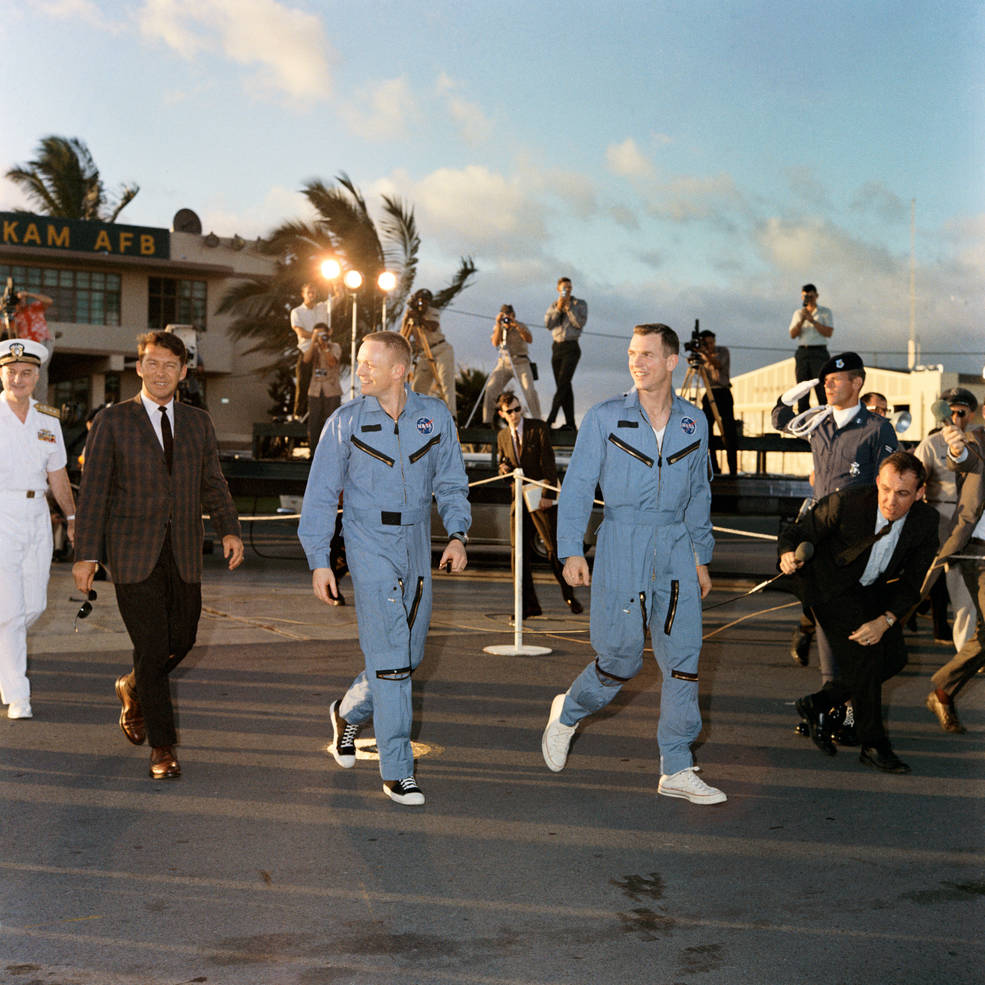
Left: The destroyer U.S.S. Leonard F. Mason arriving in Naha Port in Okinawa, Japan, with Gemini VIII astronauts David R. Scott, left, and Neil A. Armstrong, seen standing on deck at upper left. Image credit: Stars and Stripes. Middle: Armstrong and Scott walk off the U.S.S. Mason at Naha Port, accompanied by Gemini VI astronaut Walter M. “Wally” Schirra. Image credit: Stars and Stripes. Right: At Hickam Air Force Base, Honolulu, Schirra, left, accompanies Armstrong and Scott to their aircraft for the flight to Cape Kennedy.
At Naha Port, a crowd of servicemen and local citizens gathered to welcome the U.S.S. Mason and the Gemini VIII crew. Gemini VI astronaut Walter M. “Wally” Schirra, in Honolulu at the time of the in-flight emergency and on his way home to Houston from a goodwill tour in Asia, traveled instead to Okinawa to welcome Armstrong and Scott back to Earth and escort them back to the United States. Armstrong and Scott disembarked from the U.S.S. Mason, but NASA medical officer Dr. A. Duane Catterson ordered them back aboard for a thorough physical. Once medically cleared, they disembarked again and took a limousine to Kadena Air Force Base to board a C-135 aircraft for the trip back to Cape Kennedy with a stopover in Hickam Air Force Base in Honolulu.


Left: Gemini VIII astronauts Neil A. Armstrong, left, and David R. Scott greet well-wishers
upon their return to Cape Kennedy. Right: Armstrong, left, and Scott during the
postflight press conference, wearing the Exceptional Service Medals
they received before the event.
Armstrong and Scott greeted well-wishers upon their arrival at Cape Kennedy on March 19 and spent the next two days at KSC debriefing their mission. After their return to MSC, on March 26, the two astronauts received Exceptional Service Medals for their heroic response to the in-flight emergency, following which they held a press conference to inform reporters about their mission.


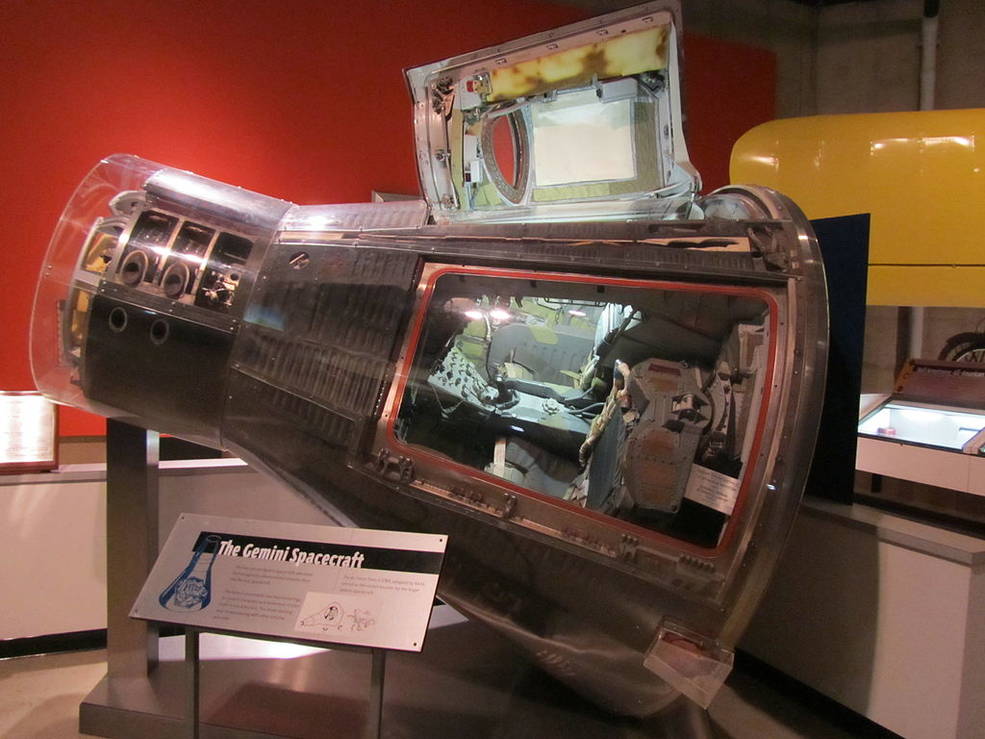
Left: The members of the Gemini Goodwill Tour, including Janet and Neil A. Armstrong, Barbara and Richard F. Gordon, and George M. Low, deputy director of the Manned Spacecraft Center, now NASA’s Johnson Space Center in Houston, pose in front of their aircraft. Middle: Gordon, left, and Armstrong pose with children during the Gemini Goodwill Tour’s stop in Santiago, Chile. Right: The Gemini VIII spacecraft on display at the Neil Armstrong Air and Space Museum in Wapakoneta, Ohio.
Following the success of previous international visits by American astronauts, President Lyndon B. Johnson organized a Gemini Goodwill tour for Armstrong and Gordon, who, in addition to being Scott’s backup on Gemini VIII, flew on Gemini XI in September 1966. Accompanied by their wives Janet and Barbara, respectively, and MSC Deputy Director George M. Low, Armstrong, and Gordon visited 9 Latin American countries (Colombia, Brazil, Ecuador, Peru, Bolivia, Uruguay, Argentina, Chile, and Panama) between Oct. 7-31, 1966.
The Gemini X crew of John W. Young and Michael Collins revisited Gemini VIII’s Agena target in July 1966 but did not dock with it, making a passive rendezvous with the inactive spacecraft. They found it stable and in good condition. Using a hand-held maneuvering unit during a spacewalk, Collins flew from the Gemini X spacecraft to the inert Agena and retrieved a micrometeorite collector panel from its exterior, completing a task unfinished by the Gemini VIII crew. The Agena VIII target spacecraft reentered the Earth’s atmosphere on Sep. 15, 1967, the last piece of Gemini Program hardware to leave orbit. The Gemini VIII spacecraft is on display at the Neil Armstrong Air and Space Museum in Wapakoneta, Ohio.
Although Armstrong and Scott distinguished themselves during the in-flight emergency, NASA didn’t assign an all-rookie crew to a spaceflight again until the Skylab-4 mission in 1973. Both excelled in their later astronaut careers, Armstrong as the first man to step on the lunar surface during Apollo 11 in 1969, and Scott as the first man to drive on the Moon during Apollo 15 in 1971. They were the only Gemini crew whose both members walked on the Moon.
























